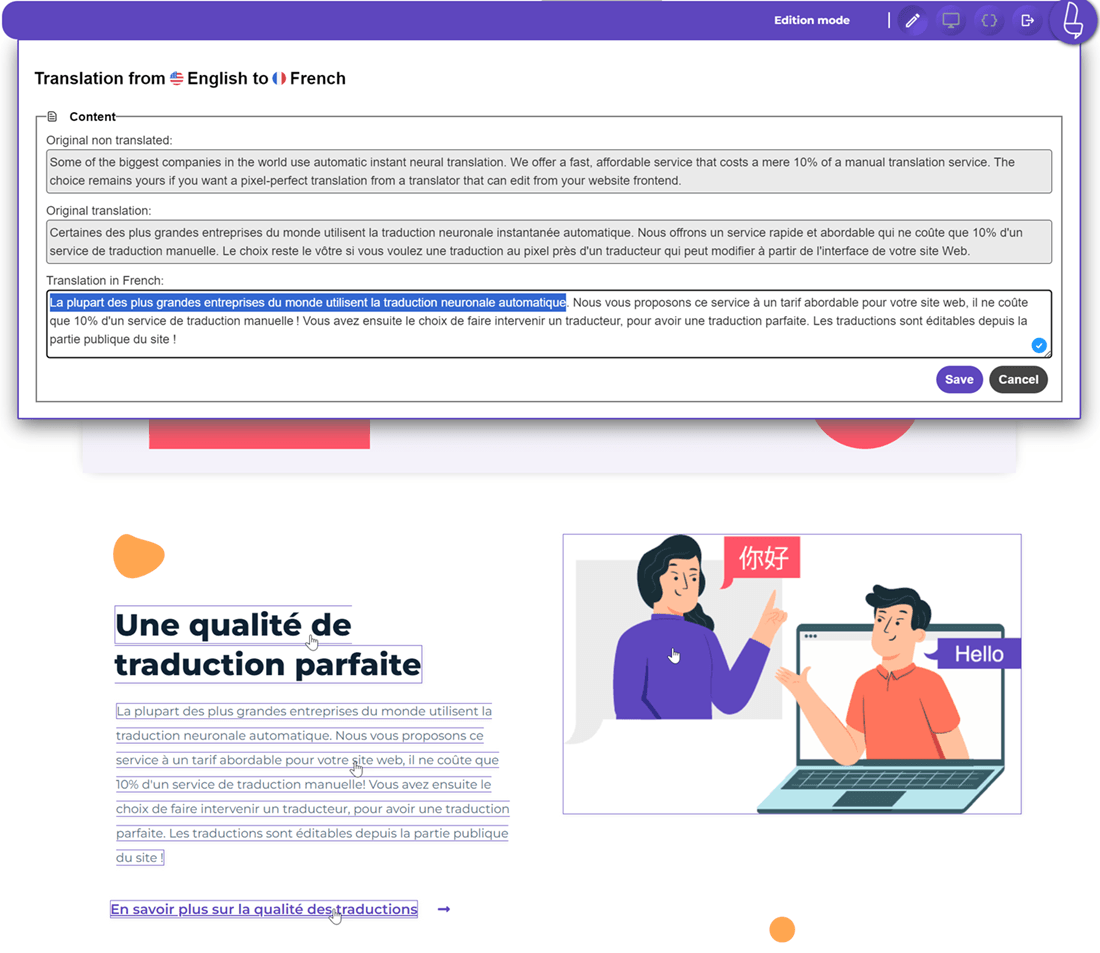When creating a multilingual website, choosing the right English variant—British or American—can be more important than you think. While both are widely understood, subtle differences in spelling, grammar, tone, and cultural references can affect how your message is received by users in different regions. Getting these nuances right helps ensure that your content feels natural, relatable, and trustworthy.
This article breaks down the key differences between British and American English, explores how to choose the best option for your target audience, and explains why English localization matters for global businesses whether you’re launching a product in the UK or expanding to the US market, making the right language choice can give your website a clear competitive edge.
Why English localization matter for businesses?

English localization plays a crucial role in helping businesses connect meaningfully with diverse audiences across regions. Even though English is widely spoken, the nuances between its variants—such as British and American English—can influence how content is perceived. Website localization ensures that your message doesn’t just get translated, but also resonates with local customs, expectations, and communication styles. When users feel that content has been tailored specifically for them, it builds trust, engagement, and ultimately, loyalty.
Moreover, localized English content can significantly impact your brand’s professionalism and credibility. For example, a UK-based user might feel disconnected from a website that uses American spelling and idioms, assuming the brand is foreign or inattentive to local preferences.
Beyond user experience, localization also supports SEO by aligning your content with region-specific keywords and search habits, boosting your visibility in local search results. In short, English localization isn’t just a linguistic choice—it’s a strategic decision that directly affects business growth, customer satisfaction, and online discoverability.
Key differences between British and American English

Although British and American English have the same linguistic roots, they have evolved into variants with unique characteristics that set them apart.
Understanding these differences is crucial when creating multilingual content or localizing a website. This will ensure that the audience feels that the content is tailor-made for them. To that end, let’s examine the key differences between the two in more depth.
Spelling differences

The difference in spelling between British and American English is often the first thing you notice.
British English tends to maintain spellings closer to its French or Latin origins, whereas American English simplifies many words for efficiency and consistency.
For example, words ending in “-our” in British English are usually changed to “-or” in American English, such as colour (UK) vs. color (US), favour vs. favor, honour vs. honor. In addition, British English uses “-ise” while American English prefers “-ize”, such as organise vs. organize, realise vs. realize. Words ending in “-re” in British English often become “-er” in American English, such as centre vs. center.
Using spellings that do not match the variants expected by the audience can make the writing feel unfamiliar or even erroneous. Spelling also affects search engine results, so choosing the right spelling can impact SEO optimization.
Grammar variations
While the general sentence structure of British and American English is quite similar, a number of grammatical variations can affect the style and feel of communication. One example is the use of tense.
British English is stricter in its use of the present perfect tense to indicate actions that have just happened or are related to the present. In contrast, American English often uses the simple past tense in the same context.
For example:
- British: I’ve just eaten.
- American: I just ate.
Another difference lies in the use of collective nouns. British English may use plural verbs for collective nouns such as team or government (e.g., The team are winning), while American English almost always takes them as singular (The team is winning).
In addition, certain expressions such as the use of “shall” are more common in the UK than in America which prefers “will”.
Understanding these differences is especially important when you are writing content that involves instructions, explanations, or official narratives. Using the right sentence structure can improve clarity and reader comfort.
Vocabulary differences
The vocabulary differences between British and American English are vast and can be confusing for those who are unfamiliar with them. Even common everyday words can differ drastically between the two variants.
For example, boot in British English refers to the trunk of a car, whereas in American English, a boot is a shoe. Flat means apartment in British English, but in American English, flat is more commonly used to describe a flat surface or tire. Even food terms can be different; a biscuit in the UK is a pastry like a pineapple tart, while in America, a biscuit is a soft bread like a scone.
Using the wrong vocabulary for your target market can cause confusion or even misunderstanding. Therefore, it is important to tailor your word choice to your audience for effective and natural communication.
Politeness and formality
British English communication style is generally more formal and indirect. British people tend to use more refined and polite phrases as a form of communication etiquette. Meanwhile, American English tends to be more direct, expressive, and sometimes more casual in the same situation.
For example, if asking for a favor, British English speakers might say “Would you mind helping me, please?” or “I was wondering if you could…”, while American English more often uses “Can you help me?” or “Could you help me out?”
For some audiences, the British style may feel too stiff or circuitous, while the American style can come across as too to the point or even rude if not used carefully. Therefore, tailoring the level of formality and politeness to the local culture is essential, especially if you are in the customer service, education, or professional communication sectors.
Pronunciation and phonetics

One of the most noticeable but often overlooked differences is the pronunciation or phonetic aspect. British English and American English have different pronunciation systems for many words. This difference is important if you are creating video content, voice-overs, or even voice-based interactive services.
A common example is the word schedule, which is pronounced as /ˈʃɛdjuːl/ in British English and /ˈskɛdʒuːl/ in American English. Or advertisement, which in British English is /ədˈvɜːtɪsmənt/, while in American English it becomes /ˈædvərˌtaɪzmənt/. Even the letter “r” is often pronounced more clearly in American English, whereas in British accents, especially Received Pronunciation (RP), the “r” at the end of words is often ignored.
While pronunciation may not be directly noticeable in written content, in today’s media-rich digital world, using the right voice and accent can make your content feel more professional and personal to your audience.
Idiomatic expressions
Idioms are an important part of everyday language, but they can also be a source of confusion when used across language variants. British and American English have unique idioms that are not always universally understood.
For example, a British idiom such as “throw a spanner in the works” might be confusing for speakers of American English, who are more familiar with the expression “throw a wrench in the works” with the same meaning. Likewise, “not my cup of tea” is popular in the UK, whereas Americans may use “not my thing.”
Using appropriate local idioms can increase the appeal of content, but using idioms that are unfamiliar to your audience can actually reduce the effectiveness of the message. That’s why it’s important to not only translate but also culturally adjust idioms when doing the localization process.
Here is a table of key differences between British and American English.
Aspect | British English | American English |
Spelling | Tends to preserve French or Latin roots. Uses “-our”, “-ise”, “-re” (e.g., colour, organise, centre). | Simplifies spellings for efficiency. Uses “-or”, “-ize”, “-er” (e.g., color, organize, center) |
Grammar | Stricter use of present perfect tense (e.g., I’ve just eaten). Allows plural verbs for collective nouns (e.g., The team are winning). | More flexible with tense, often uses simple past (e.g., I just ate). Treats collective nouns as singular (e.g., The team is winning). |
Vocabulary | Uses different everyday terms (e.g., boot = car trunk, flat = apartment, biscuit = cookie). | Uses alternative terms (e.g., boot = footwear, apartment = housing, biscuit = soft bread). |
Politeness & Formality | Tends to be more formal and indirect (e.g., Would you mind helping me?). | Generally more direct and casual (e.g., Can you help me?). |
Pronunciation & Phonetics | Distinctive accents; less pronounced “r” at the end of words. Schedule as /ˈʃɛdjuːl/, advertisement as /ədˈvɜːtɪsmənt/. | Clearer pronunciation of “r”. Schedule as /ˈskɛdʒuːl/, advertisement as /ˈædvərˌtaɪzmənt/ |
Idiomatic Expressions | Uses idioms like throw a spanner in the works, not my cup of tea | Uses idioms like throw a wrench in the works, not my thing. |
How to choose the right variant for your website?

Deciding whether to use British or American English isn’t just a matter of spelling—it’s a strategic choice that can influence how your audience receives your content, how it performs in search engines, and how consistent your brand voice appears. To make the right decision, you need to consider several key factors that go beyond language preferences.
Here are the most important points to guide you in choosing the right English variant for your website.
Identify your target audience
The first and most crucial step is understanding who your website is meant for. If your primary audience is located in the United States, using American English would make your content feel more familiar and trustworthy to them. Similarly, suppose your users are predominantly in the UK, Australia, or countries that favor British English. In that case, aligning with British spelling, grammar, and idioms will create a more localized and relatable experience.
Ignoring this alignment can lead to small but noticeable disconnects—something as simple as using the word “apartment” instead of “flat” or “color” instead of “colour” might make your content feel foreign to the reader. In user-focused content like product descriptions, help articles, or blog posts, this can affect trust and engagement. That’s why audience localization should always come first in language decisions.
Align with regional language variants

If your multilingual site includes localized versions (e.g., French for France, Spanish for Latin America), your English version should match the variant spoken in those regions. For instance, if you serve both the UK and France, British English would better match regional expectations. Similarly, if you’re targeting the US and Latin America, American English would be the natural choice.
This alignment helps your English variant feel consistent within the broader linguistic context of your site.
Match your brand identity and voice
Your brand voice is how your business “speaks” to your audience, and consistency in that voice builds trust and professionalism. Mixing British and American English in your content can create a disjointed experience, leading to confusion or even a perception of carelessness. For example, using “organization” in one section and “organisation” in another might seem trivial, but it signals inconsistency to a detail-oriented audience.
Choosing one variant and applying it consistently across all pages, from product descriptions to blog posts to customer support, helps reinforce your brand identity. If your brand is global, you might even consider maintaining separate regional versions of your website—each with tailored language, tone, and spelling—so every visitor feels like the site was built just for them. This level of care in localization contributes not just to clarity, but to stronger brand loyalty.
Consider your SEO strategy

Your choice of English variant also affects how search engines index and rank your content. Search queries often reflect local spelling and terminology preferences—someone in the UK will search for “favourite books,” while a US user will type “favorite books.” Using the appropriate spelling and phrasing can help your content appear in the right search results, which directly impacts visibility and traffic.
Moreover, choosing the correct variant for your domain (e.g., .co.uk vs. .com) and combining it with localized keywords can strengthen your site’s relevance in regional searches. This is especially important for businesses operating in competitive markets, where even slight differences in keyword targeting can significantly affect organic reach. A consistent SEO strategy that includes the right English variant is essential for long-term growth.
Localize your English variant with Linguise

Localizing your chosen English variant—whether British or American—is essential for maintaining a consistent and professional presence on your multilingual website. When your site serves a global audience, even subtle differences in spelling, vocabulary, and tone can affect how your message is received.
Ensuring that your English content aligns perfectly with the preferred variant of your target market helps create a seamless user experience, reduces confusion, and strengthens your brand identity across regions.
This is where Linguise translation tools becomes a valuable tool. Linguise offers a powerful front-end live editor feature that lets you easily review and adjust translations directly on your website. If any translated content doesn’t quite match your selected English variant, you can quickly fine-tune it to reflect the right spelling, phrasing, or style—whether British or American English.
This flexibility ensures your localized content stays accurate and natural, helping your website communicate clearly and effectively with every visitor.
Conclusion
Choosing an English variant between British or American—for a multilingual website is not just a matter of preference but a strategic decision that impacts audience, SEO optimization, and brand voice consistency. Understanding the key differences between these two variants, from spelling, grammar, and vocabulary to communication styles and idioms, allows content to feel more natural and relevant to users in the target region.
To facilitate an accurate and efficient localization process, make sure you use automated translation tools that can adjust language variants according to your audience’s needs in real time.
For example, with Linguise translation tools, you can ensure that your website content is not only translated, but also customized according to the English variant you use, so that every visitor feels like the content is really made for them. Start trial Linguise to grow your multilingual website today!





